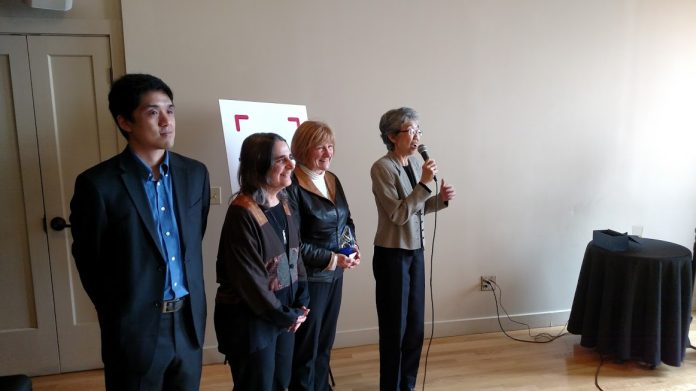Supporters, colleagues and elected officials gathered at Seattle’s Westin Hotel for Futurewise’s Spring Breakfast Livable Community Awards on March 2nd. The awards lifted up six groups that have excelled in community-building to advance equity and environmental causes. The winners were Kittitas County, the City of Bellevue, Beacon Food Forest, Roosevelt Neighborhood Association, King Conservation District, and Yesler Community Collaborative.
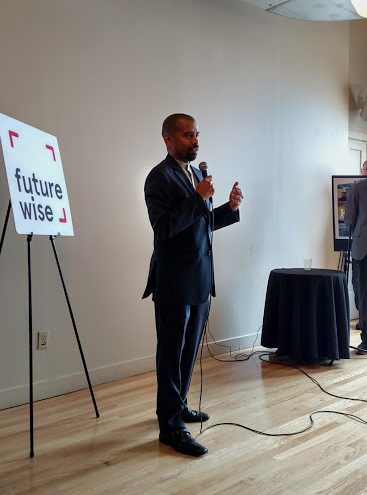
Futurewise is a Seattle-based statewide organization dedicated to sustainable urban planning practices. It was founded to help implement the Growth Management Act, which was adopted in 1990. “For more than 25 years, Futurewise has worked to prevent sprawl in order to protect our State’s resources and make our urban areas livable for and available to all,” Futurewise wrote. “We focus on preventing the conversion of wildlife habitat, open space, farmland, and working forests to subdivisions and development, while directing most growth into our urbanized areas. Our mission also incorporates an important focus on livability, housing, transportation, social justice, environmental justice and environmental quality in our urbanized areas.”
Dwayne Marsh was the keynote speaker for the event. Futurewise has posted his presentation here. Marsh is Deputy Director of Government Alliance on Race and Equity for the Center for Social Inclusion, a national organization which set its mission as dismantling structural racism. Marsh’s presentation included recommendations for what people of various professions and communities can do to further that mission. For example, he suggested developers seize the opportunity to integrate community benefit, environmental sustainability, and commercial viability into their projects.
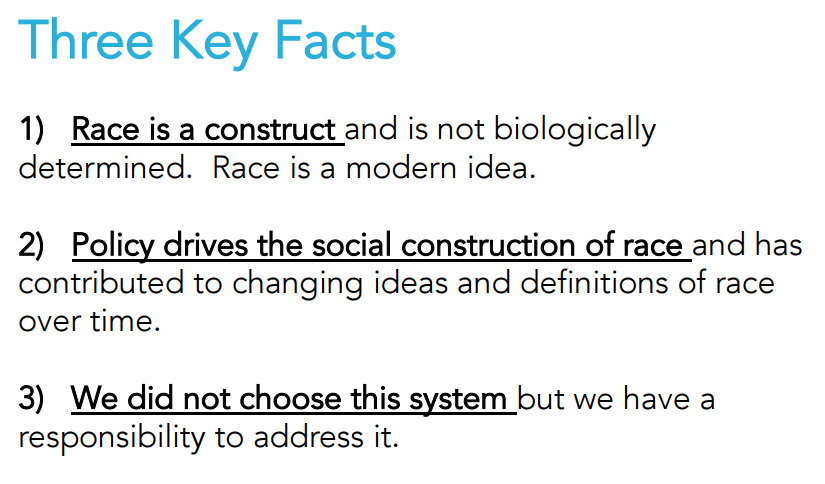
Kittitas County Leads The Way On Water
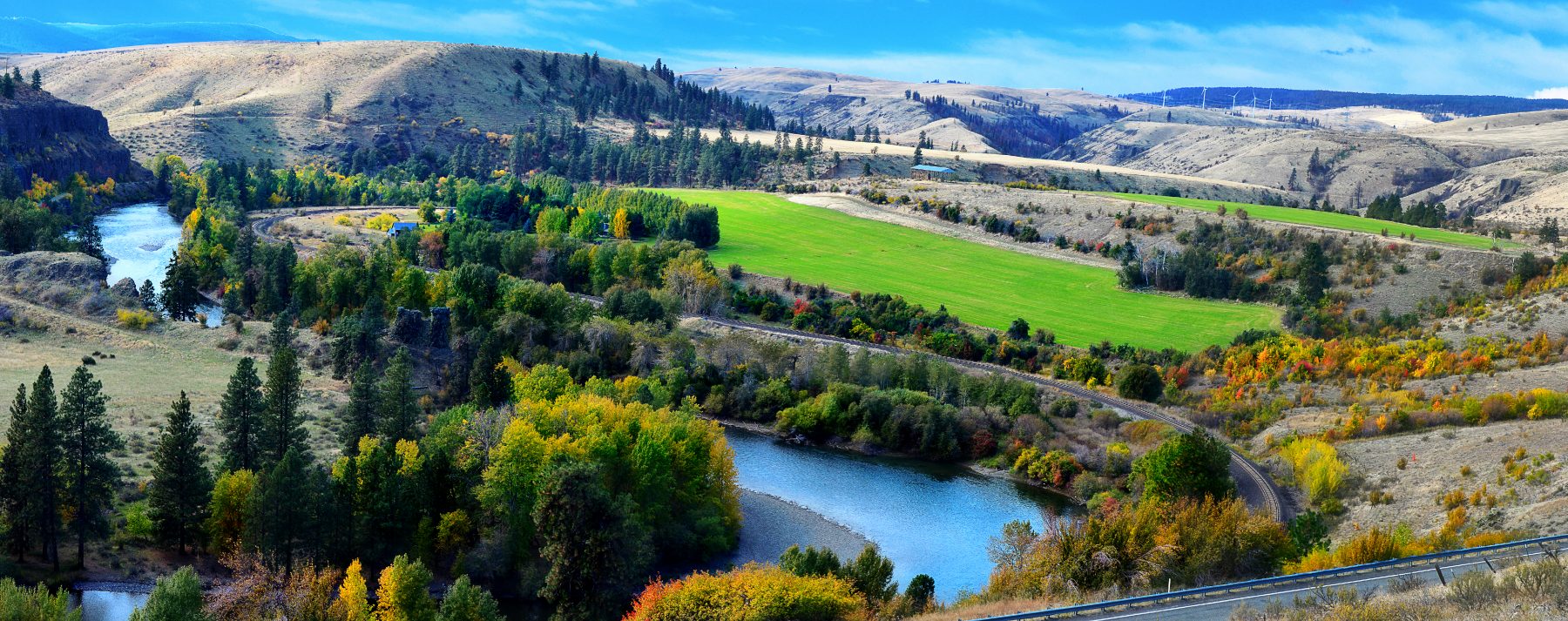
Kittitas County Water Banking and Mitigation Program won in the category of Local Government Excellence in Programs, Policies and Regulations for its innovative programs to plan sustainable growth around water rights.
Last year, the Washington State Supreme Court handed down a landmark decision, Hirst v. Whatcom County. It clarifies counties’ existing obligations to ensure that as they plan for new development in rural areas, there is adequate water available to accommodate the new homes without impacting neighbors’ wells, senior water rights, or the water that flows in nearby rivers and streams. Some counties, like Kittitas, have been actively working to better plan for development, and the related impacts on ground and surface water, for quite some time. In fact, it was two years ago that Kittitas County implemented regulations requiring mitigation for development impacts on the Yakima River, and initiated a public water bank for single-family residential homes in rural areas. These types of sustainable solutions can serve as a model for addressing water availability issues state-wide.
“In rural areas we need to start planning for growth in accordance with where there is water available and where it’s not impacting rivers and streams,” Futurewise Executive Director Christoper Wierzbicki said while presenting the award after the breakfast. Wierzbicki added, “Republican legislators this year in Olympia have made this their top priority, overturning this case–more important than schools, more important than anything else.”
“We know that there are communities who are dealing with [the Hirst Decision] in a really proactive way and that’s Kittitas,” Wierzbicki said. “They are really to be commended for driving a solution to this problem.”
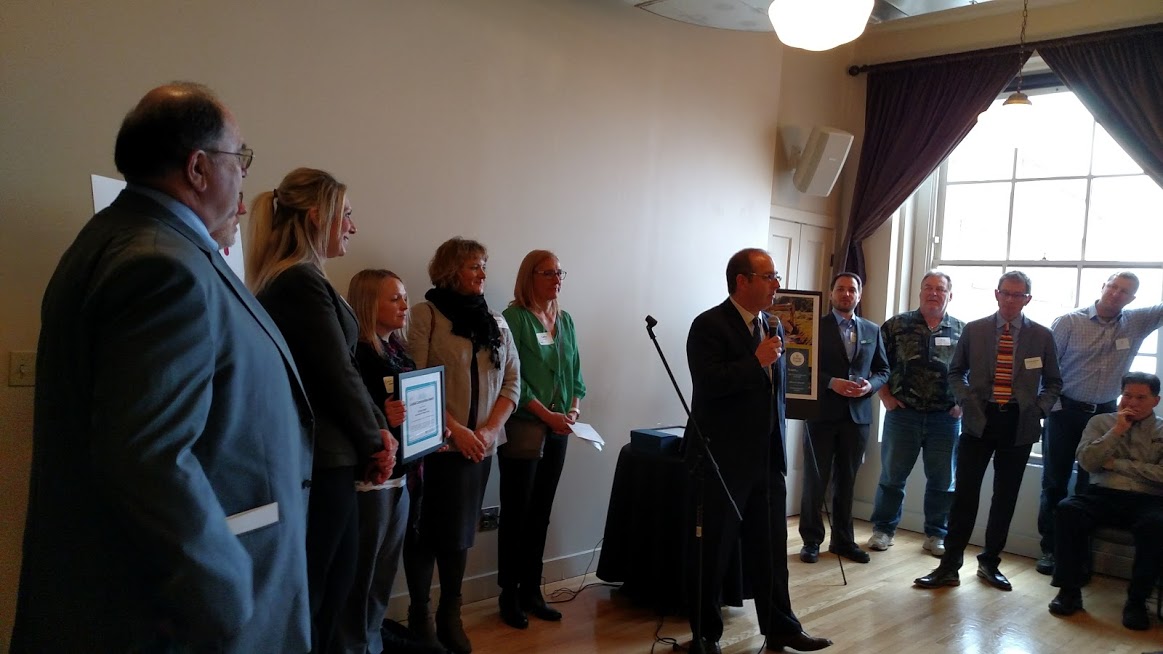
Kittitas County Commissioner Paul Jewell accepted the award.
“It took me a while to actually come to grips that a rural conservative Republican county commissioner is standing here before you accepting an award from Futurewise,” Jewell said. “If I were a betting man, I’d never have bet on this happening.”
“We’ve really built some great relationships with Futurewise,” Jewell said. “Without their desire and their drive and their willingness to take some risks with Kittitas County, we wouldn’t have been able to do the work that we did, and we certainly wouldn’t be standing here in front of you.”
“We had to trade in a lot of political chips over time to make this thing work, but in Kittitas County it’s really considered normal today, and that’s kind of a miracle,” Jewell said.
To conclude his speech Jewell asked that the fruitful collaboration continue: “We’re going to continue to need your help; we hope we can count on you.”
City of Bellevue Grows Up While Growing Downtown Park Too
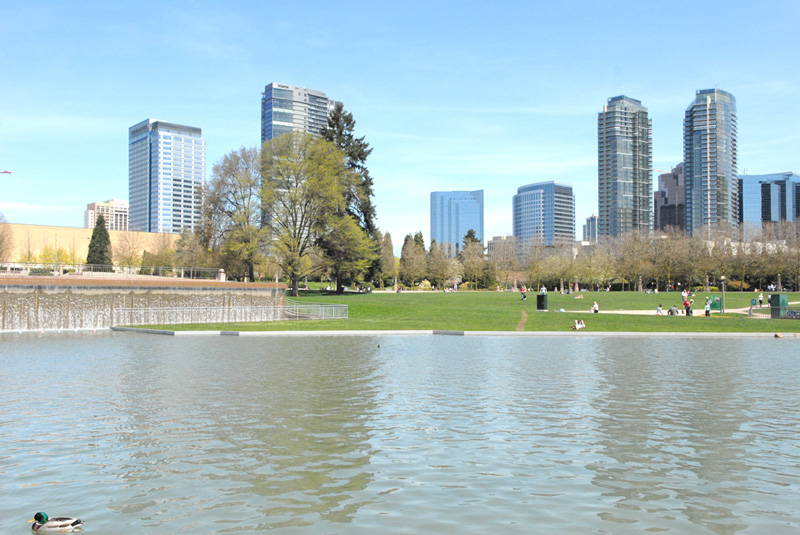
Futurewise gave an award for Excellence in Smart Growth to the City of Bellevue for its Downtown Park:
Too often, urban density takes precedence over other valuable assets that contribute to a community’s sustainability, vibrancy and livability. In 1983, three gentlemen in Bellevue recognized the once-in-a-lifetime opportunity, and community value, of advocating for a public park in the center of what would soon become one of the densest urban centers in the region outside of Seattle. As a result of their hard work, as well as a host of other partners and elected officials from the City of Bellevue, and the generosity of Bellevue taxpayers, today the Bellevue Downtown Park is 20-acres of natural respite for thousands of residents, tourists and children that use the park daily. The last segment of the park just commenced construction last month, which will expand the public space to almost 30 acres.
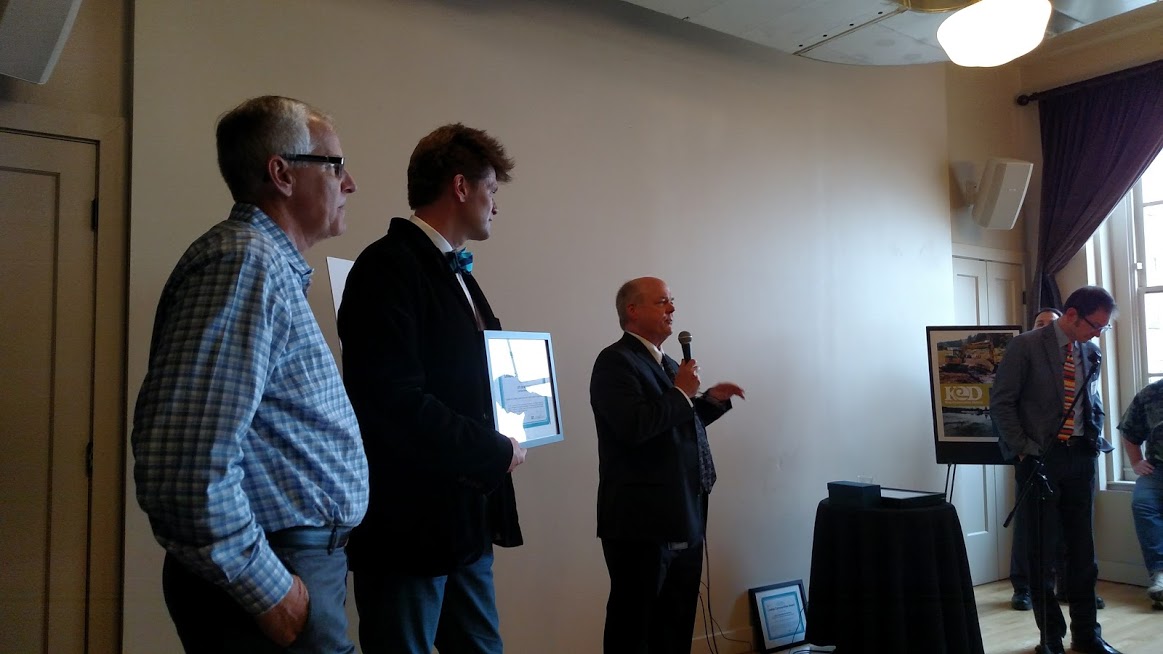
Bellevue’s Director of Parks and Community Services Patrick Foran accepted the award.
“Bellevue was undergoing a civil war; it was a civil war about are we going to grow horizontally or vertically–And there are people today who still don’t talk to each other because of that argument,” Foran said. “Luckily, because of Bellevue’s legacy of forward-thinking, visionary leadership, they chose vertical. They chose vertical for all the reason Futurewise talks about today, and this was 35 years ago. You can imagine the business community in Bellevue seeing all the activity coming out of the ground couldn’t believe 20 acres of prime developable property across the street from the Bellevue Square mall of all places and turn it into a park,” Foran said. “So there was quite the battle that was raging in Bellevue at that time.”
Foran explained how that battle both to grow vertically and densely while also preserving land for a park paid off. “Right now you won’t find a commercial development going up anywhere in Bellevue that does not have a picture of Downtown Bellevue Park front and center in their promotional material,” he said. “But more importantly on any given decent day you’ll find thousands of people enjoying the space.”
“We can’t be more pleased personally and professionally to be putting the capstone on this park,” Foran concluded.
Beacon Food Forest Pioneers Open Harvest Model
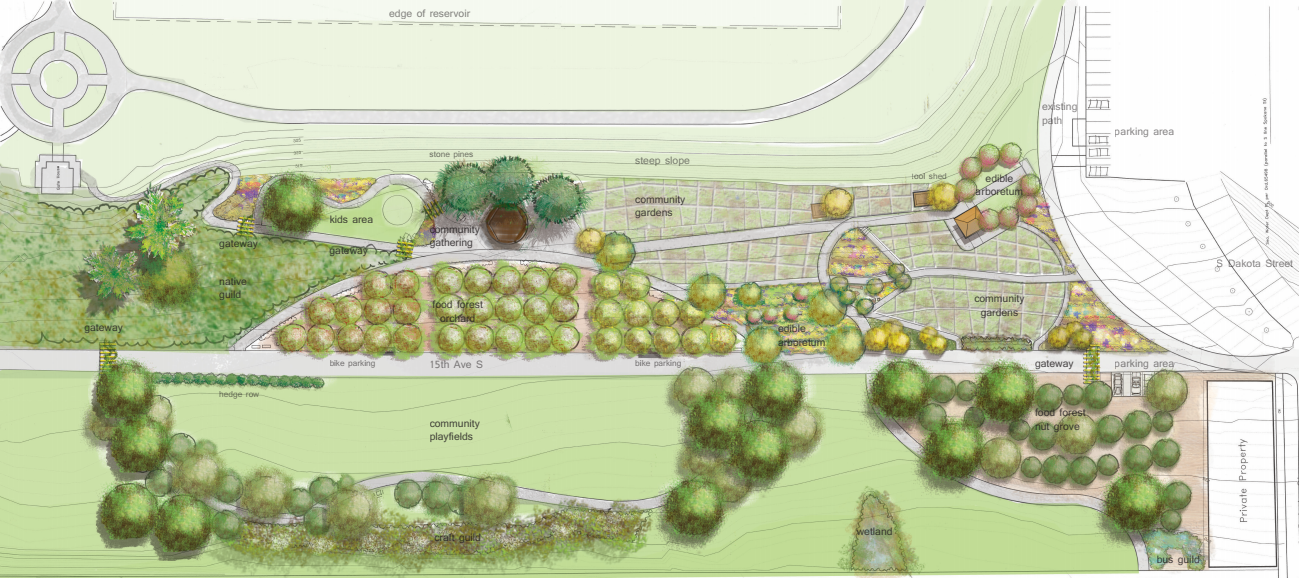
The award in Excellence in Creating Livable Communities, Equity, and Environment went to Beacon Food Forest, which is a volunteer-built and operated permaculture project in Seattle’s Beacon Hill neighborhood and the largest food forest on public land in the United States. Futurewise highlighted less than half of Seattle residents live in areas with close proximity to a farmers market or grocery store, which is a gap Beacon aims to close.
Created on a former grassy area on unused Seattle Public Utilities land, it was initiated as a class project in 2009 and later gained tremendous community and city support. Now, it spans almost 2 acres, has been approved for an additional 1.75 acre Phase 2, and can expand up to a total of 7 acres – an urban oasis in the middle of Seattle’s most diverse zip code.
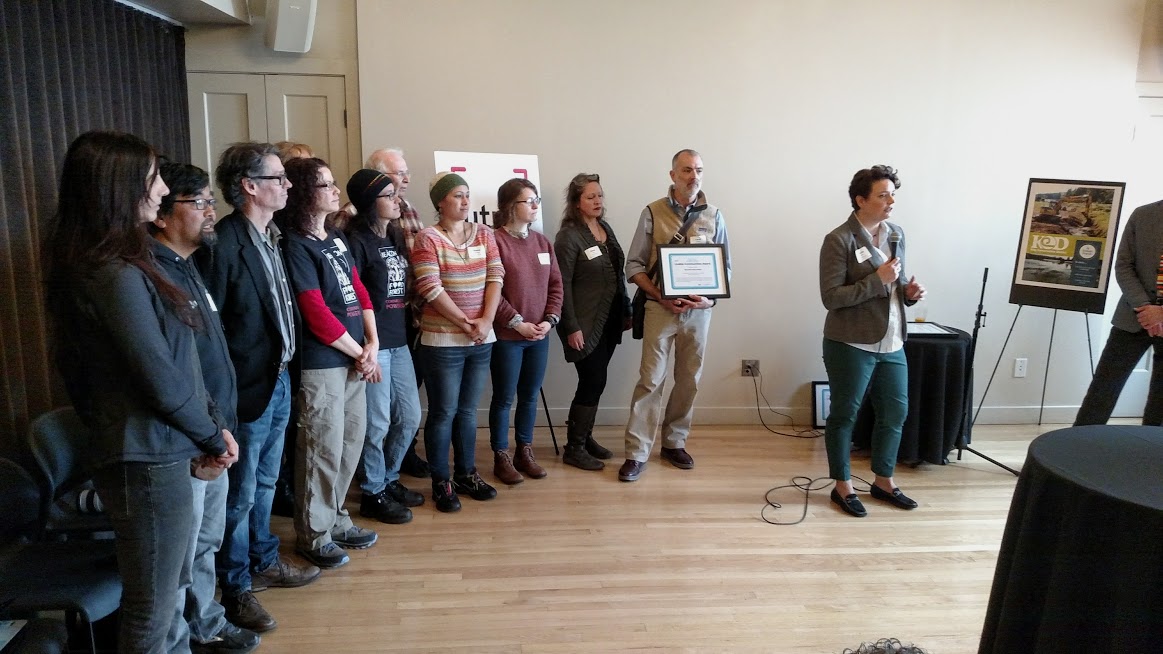
Volunteer Melanie Coerver accepted the award for Beacon Food Forest.
“It became a question of human nature. So many people were skeptics. They said how can you create a place with an open harvest policy? Everybody will steal things. We got a story on NPR and someone called up afterward and was like: this is terrible; you’re going to grow food in a public space–what if people urinate out there?”
“So, we got a lot of skeptics, but we said you know we think we can make this work; the community will actually support this program,” she said. “What do you know, we were right.”
“If you are feeling down, I encourage you to come to the Beacon Food Forest because it’s a laboratory of so much goodness,” she said. “It’s about neighbors helping each other; it’s about education, and it’s about environmental projects that just warm my heart–we’ve got we tand restoration, soil-building and composting, and of course growing local organic food and sharing with everybody who needs it.”
“The good news is we’re going to double in size,” she said. “We’re already having thousands of pounds of food.”
Roosevelt Neighborhood Association Proactively Plans Light Rail Station Area
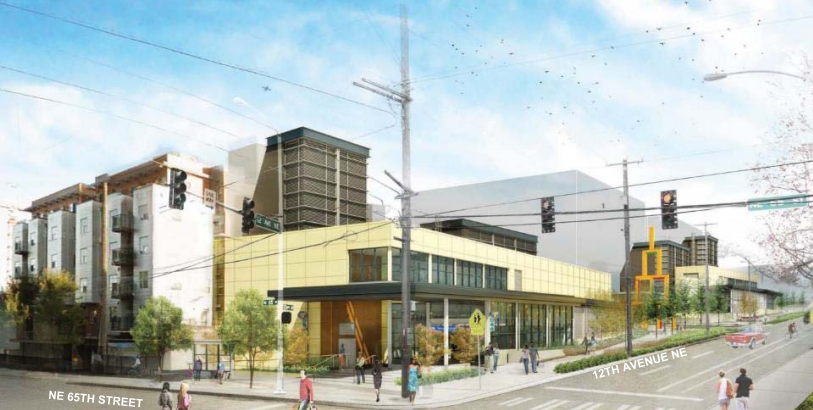
Futurewise gave an award for Excellence in Creating Livable Communities, Smart Growth and Transportation to Roosevelt Neighborhood Association. Land Use Committee Chair Jay Lazerwitz accepted the award which recognized the work the group did in station area planning, transit-oriented development, and affordable housing. Futurewise suggested Roosevelt could serve as a model for other neighborhood getting light rail access:
The Roosevelt Neighborhood Association is taking cues from lessons learned in other transit station planning processes across Seattle, and is driving an inclusive process for planning around the new Roosevelt Station that encourages affordable housing, sustainable design, and a focus on community principles. Their work is only just beginning, but their approach serves as a model for other neighborhoods that will soon be touched by transit access.
Christoper Wierzbicki: “Roosevelt Neighborhood Association has recognized that privileged communities need to embrace density, need to embrace affordable housing, and opportunities for affordable housing in their communities.”
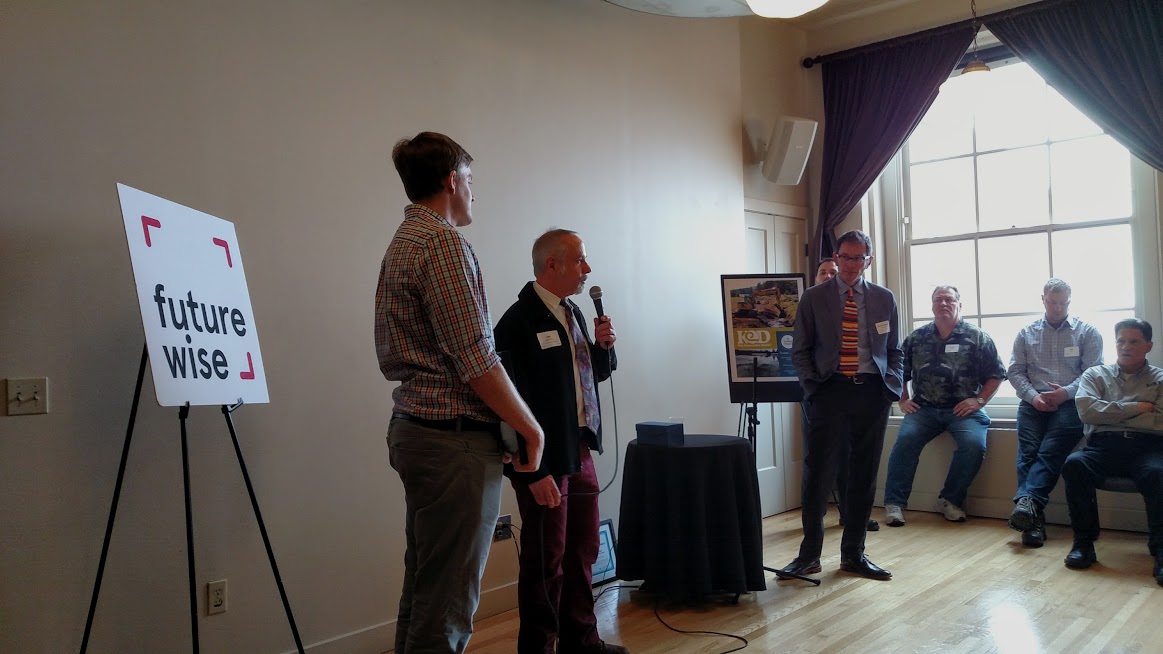
“In the early 2000’s, the community came together and pushed for the relocation of the [light rail] station not along the I-5 corridor but in a central location in the community,” Lazerwitz said. “Later in the 2010 rezone, it was the community that came together and actually increased the density planning for the neighborhood above and beyond what the City metrics were asking at that time.”
Roosevelt Neighborhood Association put together a land use academy workshop series to deal with their transit-oriented development opportunities, including the Sound Transit owned site adjacent to the station. The group also applied for a grant from the Enterprise Community Partners, and received that in the fall.
“We decided from that point on to work hand and hand with Sound Transit to do community engagement,” Lazerwitz said. “We’ve heard a lot of strong support for many years for affordable housing.”
“The light station station will be keystone place,” Lazerwitz said. “We’re at a milestone where we just finished three workshops with Sound Transit. The outcome… a strong mix of affordable housing as well as meeting some community goals–the sites along NE 66th St as a green street designation, so pushing for public gathering space as a community benefit.”
Sound Transit will put out a request for proposals in the near future. The light rail station will open in four years, and Roosevelt Neighborhood Association continues to be a proactive partner in planning for the growth associated with it.
King Conservation District Increases Bounty Along Waterways
Futurewise gave the Overall Excellence in Protecting Natural Resource Areas award to the King Conservation District for its Carnation/Enumclaw Agricultural Drainage Program. The thrust of the program is to increase agricultural output in drainage and flood prone areas near waterways. Boosting the output helps shield these lands from development pressures, Wierzbicki argued.
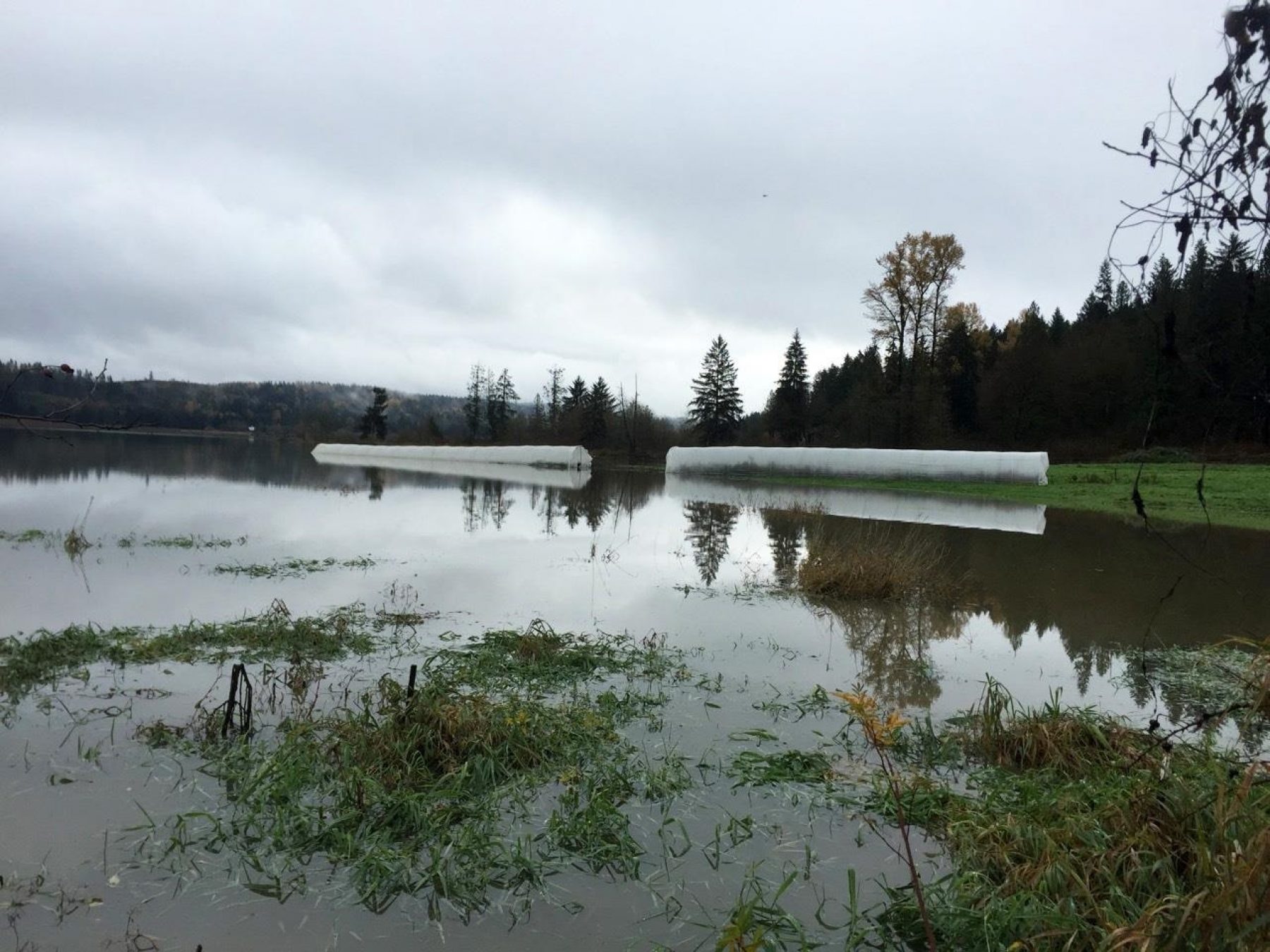
Over recent decades, much of King County’s best farm land has been negatively impacted by poor field drainage — a threat compounded by neighboring urbanization, which escalates the volume and speed of storm water runoff. As a result, farmers need help maintaining drainage ditches and culverts to improve field drainage. This increases productivity, enables the planting of higher value crops, and expands grazing for livestock. In 2015 and 2016, the King Conservation District — with funding from the King County Flood Control District and in partnership with King County Agricultural Drainage Assistance program — worked to clear more than 5 miles of impaired drainage channels in the Snoqualmie Valley, Sammamish Valley and the Enumclaw Plateau, resulting in an additional 149 acres of new production land and 458 acres of enhanced production land.
Bee Covington, the new Executive Director of the King Conservative District, accepted the award and emphasized the importance of collaboration before passing the mic to Supervisor Jim Haack to share some thoughts.
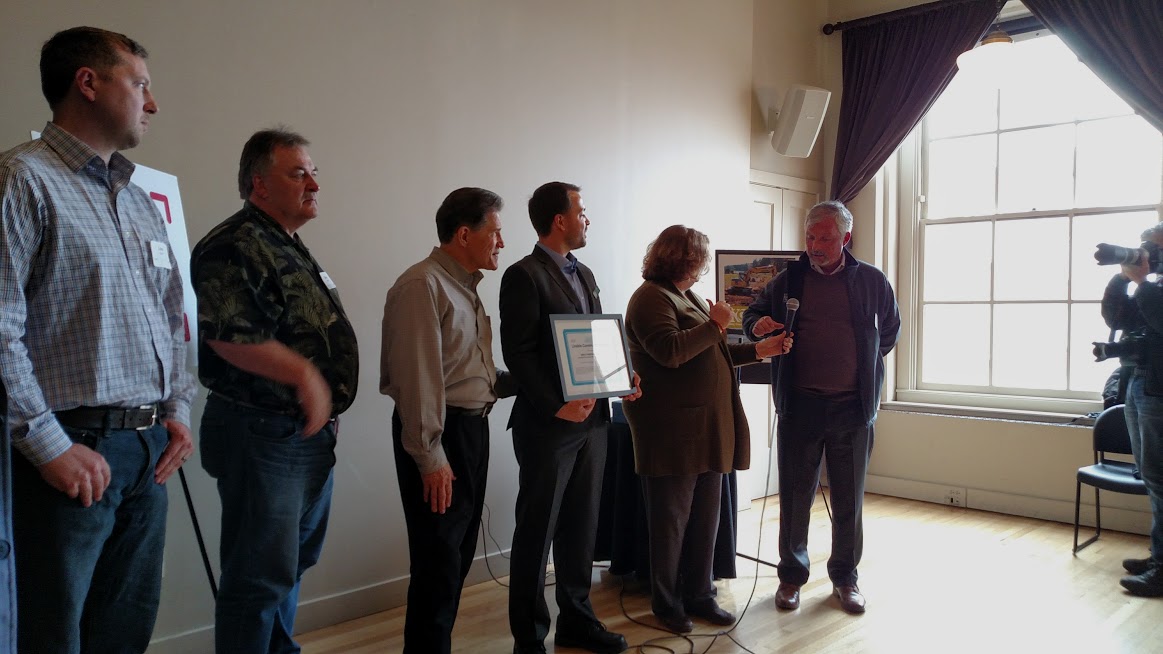
“King County is blessed with land that make a difference with local food security and sustainability,” Haack said. “Water is problem for farmers here. It’s either too much or too little.
“The subject of drainage has been a hot button for many years,” Haack said. “So it’s really terrific to be recognized in this way. The conservation district went through a survey process and realized drainage is the number one limitation and opportunity for working lands, especially adjacent to rivers. As a person who farms in the valley, I can tell you for small farmers, the difference between those few acres and the length of time they stay wet makes a large impact on their viability as a business and their sustainability.”
“Bringing this land back into production is incredibly valuable. As the Beacon folks will tell you, an acre will feed 100 families,” Haack said. “In Snoqualmie Valley there’s 6,000 acres of working lands available right outside the backdoor of this major metropolitan area… This is yeoman’s work.”
Yesler Community Collaborative Owns Growth
At the Spring Breakfast, Mayor Ed Murray presented the Community Champion Award to Doris Koo and Yesler Community Collaborative. Tying in a recent initiative from his State of the City speech, Mayor Murray cited the sugar tax as a way to help minorities by funding education programs. Koo began her presentation by showing a video Yesler Community Collaborative produced to reframe growth issues.
Koo told the crowd gathered at the breakfast: “We will work to own our growth and turn the city into truly a city for the many, so that residents, vulnerable people, small businesses, long-time residents, newcomers will share equally in the prosperity and the beauty that is Seattle and the Puget Sound.”
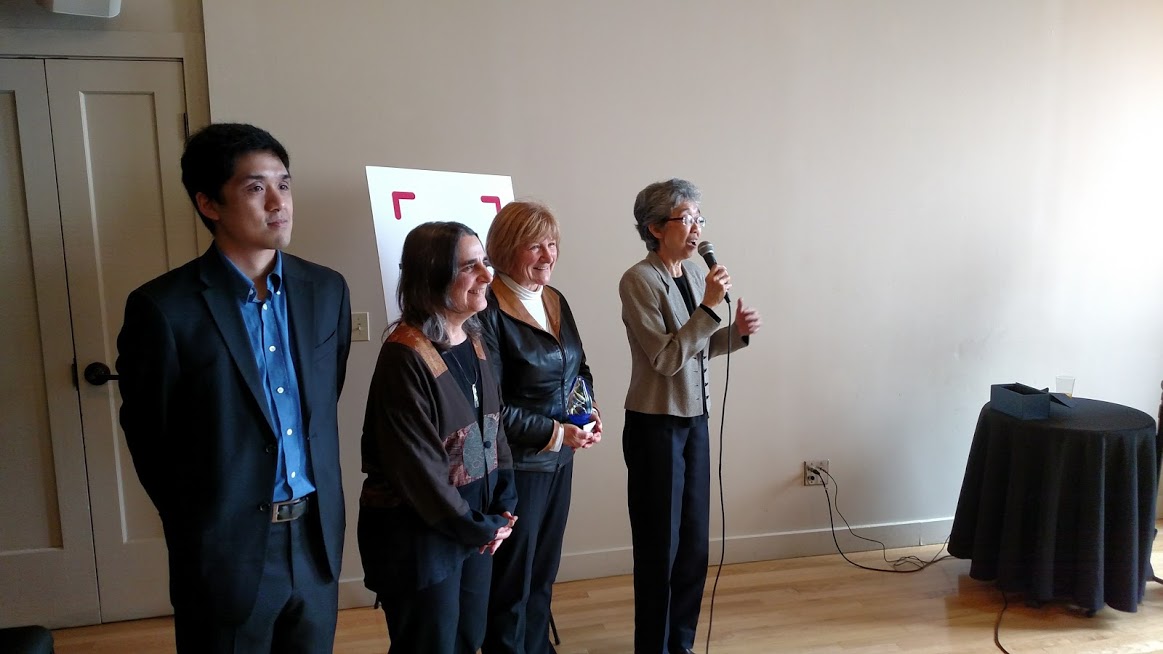
“To us the what if is about peoples and the communities, and the rich history and legacy that all these communities share as some of the earliest communities in the city,” Koo said. “It’s about people who hundred years ago had come to the country, labored, felt discriminated against, forced to be segregated. For families just 75 years ago forcibly removed from their strawberry fields just because they are Japanese Americans sent to the internment camps. For these neighborhoods to now face incredible gentrification pressure, what if we didn’t stand up together and speak in one voice together on their behalf and all of our behalves to say we need clean water, we need open space, we need food, we need conservation, we need transit and affordability, and we need to preserve history, culture and legacy. [Segregation and internment is] a chapter in history as a country we should never go back to.”
Koo talked about pulling some members out of retirement or jobs abroad: “Together we formed this backbone organization called Yesler Community Collaborative that will lend a hand in grant writing, invite Futurewise to come map through GIS some of the critical areas that could still be preserved as slivers of open space, tell our story, and be the wind behind their sales as their fight for their community’s future.”
Doug Trumm is publisher of The Urbanist. An Urbanist writer since 2015, he dreams of pedestrian streets, bus lanes, and a mass-timber building spree to end our housing crisis. He graduated from the Evans School of Public Policy and Governance at the University of Washington in 2019. He lives in Seattle's Fremont neighborhood and loves to explore the city by foot and by bike.

